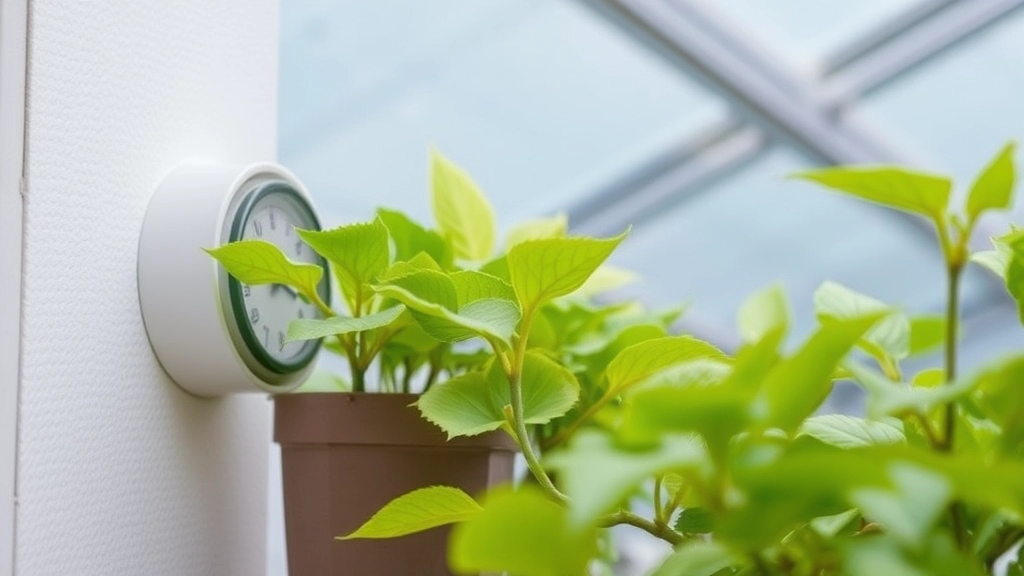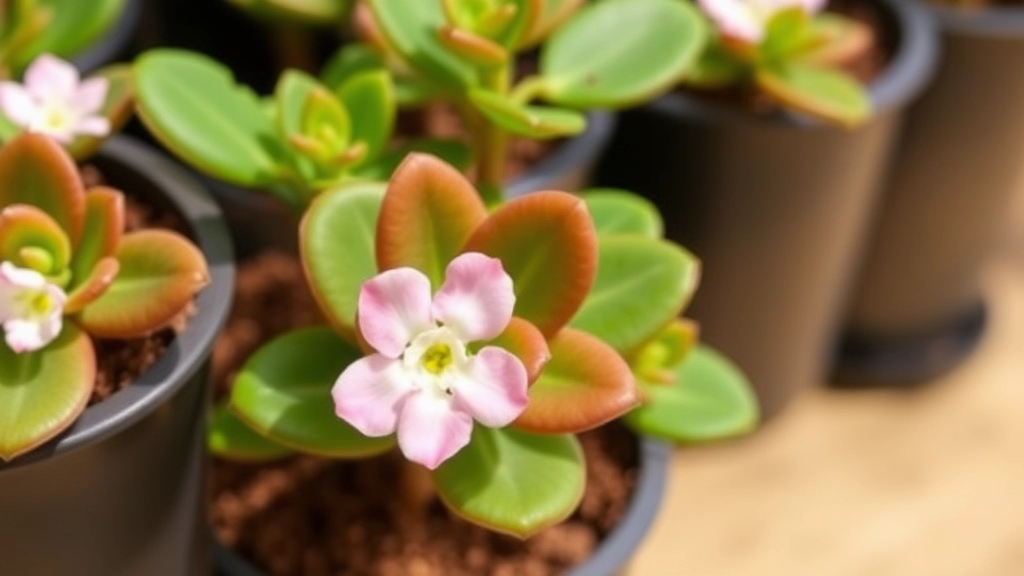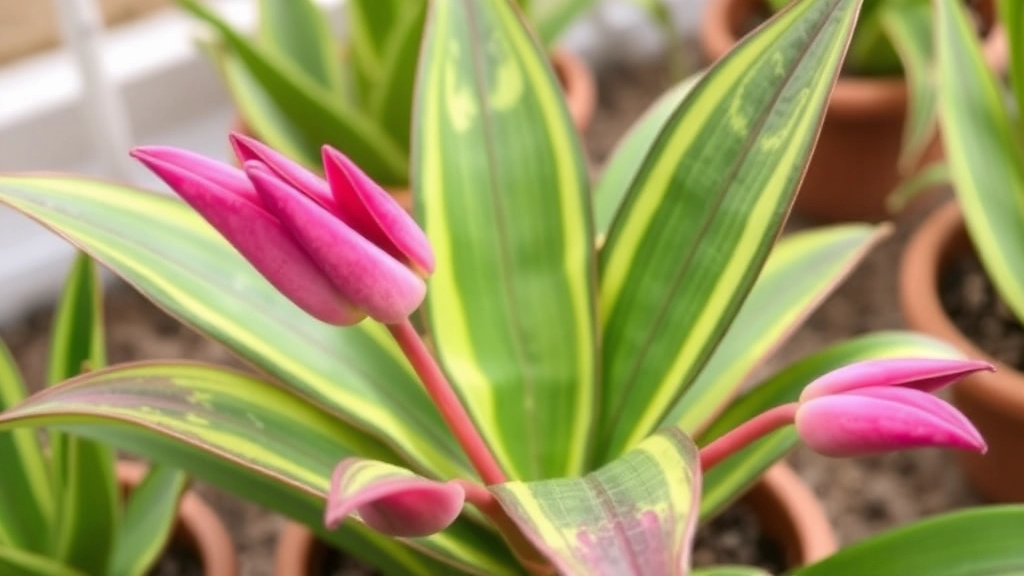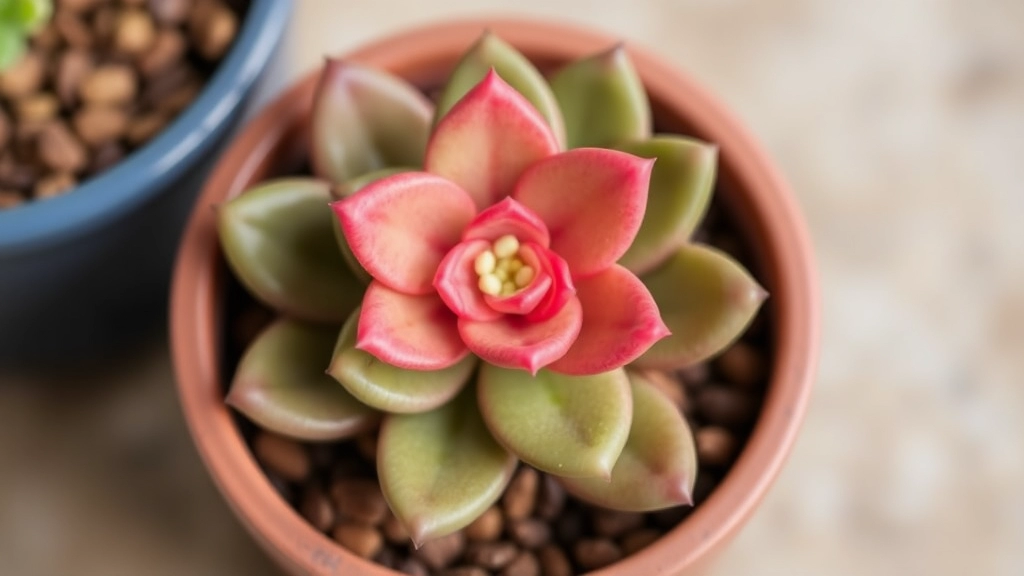Kalanchoe Paddle Plant Care Tips
If you’re looking for the best tips on Kalanchoe Paddle Plant care, you’ve come to the right place. This succulent, also known as Kalanchoe thyrsiflora, thrives with the right light, watering, and a bit of know-how. Let’s dive into how you can keep your paddle plant looking its best, whether you’re growing it indoors or outdoors.
Lighting
First off, lighting is crucial. Paddle plants love bright, indirect sunlight. Too much direct sun can scorch the leaves, but too little light can make them leggy.
Soil Choice
Next, soil choice matters. Opt for a well-draining mix to prevent root rot.
Watering
Watering should be done sparingly; let the soil dry out completely between waterings.
Additional Care
Stay tuned as we explore more on propagation, dealing with pests, and seasonal care adjustments.
Are you struggling to find the right light conditions for your paddle plant? You’re not alone. Many succulent enthusiasts face challenges when it comes to providing optimal lighting for their Kalanchoe thyrsiflora.
## Understanding Light Requirements
Paddle plants thrive in bright, indirect sunlight. Here are some key points to consider:
– **Direct Sunlight**: While paddle plants can tolerate some direct sunlight, too much can scorch their leaves. Aim for a balance.
– **Indoor Placement**: If you’re growing your paddle plant indoors, place it near a south or west-facing window. This will ensure it receives ample light throughout the day.
– **Outdoor Conditions**: For outdoor plants, partial shade during the hottest parts of the day can help prevent leaf burn.
– **Signs of Insufficient Light**: Look out for leggy growth or pale leaves, which indicate your plant may need more light.
## Adjusting Light Exposure
Adjusting your paddle plant’s exposure to light is crucial for its growth:
– **Rotate Regularly**: To ensure even growth, rotate your plant every few weeks. This prevents one side from becoming overly stretched towards the light source.
– **Seasonal Changes**: Be mindful of seasonal changes in sunlight. You may need to move your plant closer to a window in winter months when daylight is shorter.
For more detailed care tips, check out the [Optimal Care Guide for Kalanchoe Paddle Plant](https://planthq.org/optimal-care-guide-for-kalanchoe-paddle-plant/). Additionally, if you’re interested in other Kalanchoe varieties, the [Complete Care Guide for Kalanchoe Beharensis Felt Plant](https://planthq.org/complete-care-guide-for-kalanchoe-beharensis-felt-plant/) offers valuable insights.
Best Soil Types for Healthy Growth

So, you’ve got your paddle plant, and now you’re wondering about the best soil to keep it thriving, right?
Choosing the right soil is crucial for your Kalanchoe thyrsiflora, as it directly impacts its health and growth.
Ideal Soil Mix
- Well-Draining Soil:
- Look for soil that allows water to flow through easily.
- A mix designed for succulents and cacti is perfect.
- Ingredients to Consider:
- Cactus Mix: This is often a ready-made option that works wonders.
- Perlite or Pumice: Adding these helps with drainage.
- Coarse Sand: A great addition for aeration.
- DIY Soil Mix:
If you’re feeling crafty, mix:
- 1 part potting soil
- 1 part perlite
- 1 part coarse sand
Why It Matters
Using the right soil prevents water from sitting around the roots, which can lead to rot.
Trust me, no one wants to deal with that!
Signs of Poor Soil
- Wrinkled Leaves: This can indicate stress from overwatering.
- Yellowing: Often a sign that the soil isn’t draining well.
So, keep an eye on your plant and adjust the soil as needed.
Proper Watering Techniques for Succulents
When it comes to caring for your paddle plant, understanding proper watering techniques is essential. Many succulent owners often wonder, “How much water does my paddle plant really need?” or “Am I overwatering?” These concerns are common, and getting the watering right can make all the difference in your plant’s health.
Watering Frequency
- Allow Soil to Dry: Always check the soil before watering. The top inch of the soil should be completely dry.
- Seasonal Adjustments: In summer, you might need to water every 1-2 weeks. In winter, reduce this to once every 3-4 weeks.
Watering Method
- Soak and Dry: Water thoroughly until you see it drain out of the bottom. This ensures the roots get enough moisture.
- Avoid Water on Leaves: Water the soil directly, as excess moisture on the leaves can lead to rot.
Signs of Overwatering
- Wrinkled Leaves: If your paddle plant’s leaves appear wrinkled, it may be a sign of overwatering.
- Yellowing Leaves: Yellowing can indicate root rot, often caused by soggy soil conditions.
Tips for Success
- Use Well-Draining Soil: This allows excess water to escape, preventing root rot.
- Choose the Right Pot: Ensure your pot has drainage holes to allow water to flow out easily.
For more detailed guidance, check out our Kalanchoe Paddle Plant Care Guide and explore other tips for growing and caring for succulents.
Managing Temperature and Humidity Needs

Maintaining the right temperature and humidity levels is crucial for the health of your paddle plant. Many enthusiasts often wonder, “What temperature should I keep my paddle plant in?” or “Is humidity important for succulents?”
Temperature Requirements
Paddle plants, or Kalanchoe thyrsiflora, thrive in warm environments. Here are some key points to consider:
- Ideal Range: The optimal temperature range is between 20°C to 30°C (68°F to 86°F) during the day.
- Nighttime Drop: A slight drop to around 10°C to 15°C (50°F to 59°F) at night is acceptable and can mimic their natural habitat.
- Avoid Extreme Cold: Temperatures below 5°C (41°F) can damage the plant, so keep them indoors during colder months.
Humidity Levels
Humidity plays a significant role in the overall well-being of your paddle plant. Here’s how to manage it:
- Low Humidity Preference: Paddle plants prefer low humidity, ideally around 30% to 50%.
- Indoor Conditions: If your home is naturally humid, consider using a dehumidifier or placing the plant in a drier area.
- Avoid Misting: Unlike some houseplants, paddle plants do not benefit from misting. This can lead to excess moisture and root rot.
Practical Tips
- Monitor Conditions: Use a hygrometer and thermometer to keep track of temperature and humidity levels.
- Adjust Location: If your plant seems unhappy, try moving it to a different spot that meets its temperature and humidity needs.
- Seasonal Changes: During winter, ensure your plant is away from drafts or heating vents that can cause rapid temperature changes.
How to Fertilize Your Paddle Plant
When it comes to nurturing your paddle plant, or Kalanchoe thyrsiflora, fertilization plays a crucial role in promoting healthy growth. You might be wondering, “How often should I fertilize my paddle plant?” or “What type of fertilizer is best?” Let’s dive into the essentials of fertilizing this unique succulent.
Understanding Fertilization Needs
Paddle plants are relatively low-maintenance when it comes to fertilization. However, providing the right nutrients can make a significant difference in their health and vibrancy.
- Frequency of Fertilization:
- During the Growing Season: Fertilize your paddle plant once a month from spring to early autumn.
- Dormant Period: Avoid fertilizing in winter when the plant is not actively growing.
Choosing the Right Fertilizer
Selecting the appropriate fertilizer is key. Here’s a simple guide to help you choose:
- Type of Fertilizer: A balanced, water-soluble fertilizer with a ratio of 10-10-10 or 20-20-20 is ideal.
- Dilution: Always dilute the fertilizer to half the recommended strength to prevent root burn.
- Organic Options: Consider organic fertilizers like fish emulsion or seaweed extract for a more natural approach.
Application Tips
Applying fertilizer correctly can enhance your paddle plant’s growth. Here are some straightforward steps:
- Water First: Always water your plant a day before fertilizing. This helps to prevent shock.
- Even Distribution: Use a watering can to evenly distribute the diluted fertilizer around the base of the plant.
- Avoid Leaves: Be cautious not to get fertilizer on the leaves, as this can cause damage.
Signs Your Plant Needs Fertilizer
How do you know if your paddle plant is in need of nutrients? Look for these signs:
- Pale Leaves: A yellowing or pale appearance may indicate nutrient deficiency.
- Stunted Growth: If your plant is not growing as expected, it might need a boost.
For more detailed care tips, you might find our Complete Care Guide for Kalanchoe Panda Plant helpful. Additionally, if you’re interested in propagation methods, check out our guide on how to propagate Kalanchoe Mother of Thousands.
Propagating Kalanchoe Thyrsiflora: Tips and Methods

So, you’re excited to grow more Paddle Plants, right? Propagating Kalanchoe thyrsiflora can be a fun and rewarding process. Let’s dive into some easy methods that will have you multiplying your plants in no time!
Leaf Cuttings
One of the simplest ways to propagate is through leaf cuttings. Here’s how you can do it:
- Choose a Healthy Leaf: Look for a plump, healthy leaf on your Paddle Plant.
- Cut It Off: Use a clean, sharp knife or scissors to snip the leaf at the base.
- Let It Callus: Place the leaf in a dry spot for a few days. This allows the cut end to callus over, preventing rot.
- Plant It: Once callused, place the leaf on top of well-draining soil. You can lightly press it down.
- Water Sparingly: Mist the soil lightly, but don’t soak it. Keep it just moist.
Offsets
Another method is using offsets, which are small plants that grow at the base of the main plant.
- Identify Offsets: Look for small pups around the base.
- Gently Remove: Carefully separate the offset from the main plant, ensuring some roots are attached.
- Plant: Place the offset in its own pot with the right soil.
- Water: Give it a light watering and let it settle.
Seeds
If you’re feeling adventurous, you can also grow Kalanchoe thyrsiflora from seeds.
- Get Quality Seeds: Purchase seeds from a reliable source.
- Prepare Soil: Use a seed-starting mix for the best results.
- Sow Seeds: Sprinkle the seeds on top of the soil and lightly cover them.
- Water Gently: Mist the soil to keep it moist but not soggy.
Tips for Success
- Light: Ensure your cuttings or offsets get bright, indirect light.
- Patience: It may take a few weeks for roots to develop, so hang tight!
- Humidity: A little humidity can help, but avoid overwatering.
Common Problems and Solutions for Paddle Plants
As we delve deeper into caring for your paddle plant, it’s crucial to address common issues that may arise. Many plant enthusiasts often find themselves grappling with specific challenges, such as pests and wrinkled leaves. Understanding these problems and their solutions can make a significant difference in maintaining a healthy Kalanchoe thyrsiflora.
Pests
Pests can be a nagging concern for paddle plant owners. Here are the most common culprits:
- Mealybugs: These small, white, cotton-like insects often hide in the leaf axils.
- Solution: Wipe them off with a cotton swab dipped in alcohol or spray the plant with insecticidal soap.
- Spider Mites: Tiny and often invisible, these pests thrive in dry conditions.
- Solution: Increase humidity around the plant and use a neem oil spray to eliminate them.
- Aphids: These small green insects can cause stunted growth and leaf curl.
- Solution: Introduce beneficial insects like ladybugs or use a strong stream of water to dislodge them.
Wrinkled Leaves
Wrinkled leaves can be alarming, as they often indicate stress. The primary reasons for this issue include:
- Underwatering: If the plant isn’t receiving enough moisture, the leaves may shrivel.
- Solution: Adjust your watering schedule, ensuring the soil dries out between waterings.
- Overwatering: Conversely, too much water can lead to root rot, causing leaves to wrinkle.
- Solution: Ensure your pot has drainage holes and allow the soil to dry out before the next watering.
- Low Light: Insufficient light can hinder the plant’s ability to photosynthesize, leading to wrinkled leaves.
- Solution: Move your paddle plant to a brighter location, ensuring it receives indirect sunlight.
For more detailed care tips, you might want to check out our Kalanchoe Paddle Plant Care Guide and our Optimal Care Guide for Kalanchoe Paddle Plant.
Pruning and Grooming Your Paddle Plant

So, you’ve got a Paddle Plant, and it’s thriving, but have you thought about pruning it?
Many folks worry about cutting back their succulents, fearing they might damage them.
But don’t stress! Pruning is essential for keeping your Kalanchoe thyrsiflora healthy and looking its best.
Why Prune Your Paddle Plant?
- Encourages Growth: Pruning helps promote new growth and keeps your plant looking full and vibrant.
- Removes Dead Leaves: Snipping off any dead or yellowing leaves improves air circulation and reduces the risk of pests.
- Shaping: A little grooming can help maintain a pleasing shape, making your plant a standout in your collection.
When to Prune
The best time to prune is during the growing season, typically in spring or early summer.
This is when your Paddle Plant is most active and can recover quickly from any cuts.
How to Prune
Here’s a simple step-by-step guide to get you started:
- Gather Your Tools: You’ll need clean, sharp scissors or pruning shears.
- Inspect Your Plant: Look for any dead or damaged leaves.
- Cut at the Base: For dead leaves, cut them off at the base, close to the stem.
- Shape as Needed: If your plant is getting leggy, you can trim back longer stems to encourage a bushier look.
- Clean Up: Remove any fallen debris from the pot to prevent rot.
Tips for Grooming
- Be Gentle: Always handle your plant with care.
- Watch for Pests: While you’re pruning, keep an eye out for any signs of pests.
- Use Sterilized Tools: This helps prevent the spread of disease.
Pruning isn’t just about cutting back; it’s about nurturing your Paddle Plant to thrive.
Seasonal Care: Summer and Winter Adjustments
As we delve into the seasonal care of your paddle plant, it’s crucial to understand how summer and winter can dramatically affect its growth and well-being.
Summer Adjustments
During the summer months, your paddle plant will thrive with the right attention. Here are some key points to consider:
- Light Exposure: Ensure your paddle plant receives ample sunlight, ideally around 6 hours of bright, indirect light.
- Watering Schedule: Increase your watering frequency, allowing the soil to dry out completely between waterings. This prevents root rot while keeping the plant hydrated.
- Humidity Levels: While paddle plants are tolerant of low humidity, a bit of extra humidity can be beneficial during hot spells. Consider misting occasionally or placing a humidity tray nearby.
Winter Adjustments
Winter presents its own set of challenges for paddle plants. Here’s how to keep them healthy during the colder months:
FAQs on Kalanchoe Paddle Plant Care
What type of soil is best for my Kalanchoe Paddle Plant?
Use a well-draining soil mix, ideally one designed for succulents and cacti. You can also create a DIY mix with 1 part potting soil, 1 part perlite, and 1 part coarse sand.
Why is well-draining soil important?
Well-draining soil prevents water from sitting around the roots, which can lead to rot. This is crucial for the health and growth of your Kalanchoe thyrsiflora.
What temperature range is ideal for my Paddle Plant?
The optimal temperature range is between 20°C to 30°C (68°F to 86°F) during the day. At night, a drop to around 10°C to 15°C (50°F to 59°F) is acceptable.
Can my Paddle Plant tolerate cold temperatures?
No, temperatures below 5°C (41°F) can damage the plant. It’s best to keep them indoors during colder months.
How should I manage humidity for my Paddle Plant?
Paddle plants prefer low humidity, ideally around 30% to 50%. Avoid misting the plant as it can lead to excess moisture and root rot.
What are the signs of poor soil conditions?
Wrinkled leaves can indicate stress from overwatering, while yellowing often signifies that the soil isn’t draining well. Adjust the soil mix accordingly.
How can I propagate my Kalanchoe Paddle Plant?
You can propagate through leaf cuttings, offsets, or seeds. Each method has its own steps, but generally, ensure you use well-draining soil and provide bright, indirect light.
When is the best time to prune my Paddle Plant?
The best time to prune is during the growing season, typically in spring or early summer, when the plant is most active.
Why should I prune my Paddle Plant?
Pruning encourages new growth, removes dead leaves, and helps maintain a pleasing shape. It also improves air circulation and reduces the risk of pests.
How should I prune my Paddle Plant?
Use clean, sharp scissors or pruning shears. Cut dead leaves at the base and trim back longer stems to encourage a bushier look. Always handle your plant with care and use sterilized tools to prevent disease.
What are the key tips for successful propagation?
Ensure your cuttings or offsets get bright, indirect light, be patient as roots develop, and maintain a little humidity without overwatering.
How do I manage seasonal changes for my Paddle Plant?
During winter, keep your plant away from drafts or heating vents that can cause rapid temperature changes. Use a hygrometer and thermometer to monitor conditions closely.
References
-
Growing Paddle Plant Indoors
-
Kalanchoe Thyrsiflora Paddle Plant Care
-
How to Grow Kalanchoe
